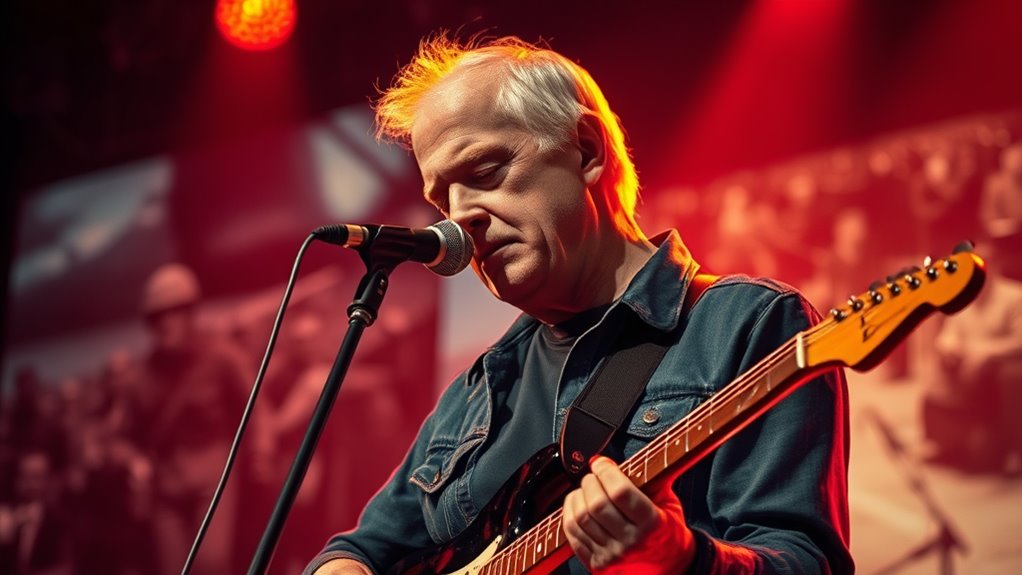When David Gilmour sings, his voice shifts from airy nostalgia to urgent protest, turning phrases like "the grass was greener" into wistful memories or "rattle that lock" into raw defiance. His guitar solos—think *Comfortably Numb*'s fractured psyche or *Time*'s panicked riff—echo lyrical tension, blending blues grit and folk storytelling. Metaphors like boats on a "silent sea" turn mortality into melody, making personal loss universal. Curious how every note holds a hidden truth? The journey gets richer.
Key Takeaways
- Gilmour's emotive vocal shifts (airy whispers to harsh shouts) mirror lyrical themes like nostalgia, urgency, and existential tension.
- Guitar solos amplify lyrical subtext, reflecting isolation, rebellion, or mortality through tone and improvisation.
- Recurring symbols (boats, grass, stone) evoke universal themes of time, loss, and resistance to emotional detachment.
- Influences from blues, folk, and psychedelia shape layered metaphors critiquing modernity, alienation, and memory's fragility.
- Ambiguous lyrics invite personal interpretation, balancing lament and defiance while exploring identity, connection, and mortality.
Emotive Vocal Delivery
Key Phrases & Imagery
- *"The grass was greener" ("High Hopes")*: Nostalgic metaphor for idealized past, paired with soft, airy vocals to evoke wistfulness.
- *"A boat lies waiting… silent sea" ("A Boat Lies Waiting")*: Mortal journey symbolized by a vessel on still waters; deep, warm tone underscores solemnity.
- *"Faces of stone" ("Faces of Stone")*: Imagery of rigidity and permanence, delivered with suppressed vocal restraint to reflect emotional distance.
- *"Rattle that lock" ("Rattle That Lock")*: Protest motif, emphasized by harsh, shouted delivery to convey urgency or defiance.
- *"darling don't make the tea" ("Darling Turn Back the Clock")*: Invitation to stay in a comforting cocoon, with Gilmour's gentle delivery enhancing the intimate plea.
Recurring Themes & Symbols
- Nostalgia/Reflection: Rivers ("endless river"), greener grass symbolize time's passage and longing. Gilmour's warm, soothing tone amplifies melancholy.
- Mortality/Loss: Boats, silent seas as metaphors for shifts into the unknown. Wordless vocals in instrumentals heighten existential weight.
- Life Changes: Stone imagery signifies unyielding change; subdued vocal delivery mirrors resignation or acceptance.
- Protest: Chains ("lock"), rebellion implied through abrupt shifts to throaty shouts, contrasting with softer passages to highlight tension.
Interpretations & Ambiguity
- "A Boat Lies Waiting": The boat's purpose (peaceful passage vs. fearful oblivion) remains ambiguous, enhanced by ethereal harmonies that leave emotional resolution open.
- "Rattle That Lock": Uncertainty whether "lock" represents societal oppression or personal constraints; harsh vocal bursts inject urgency without definitive context.
- "Faces of Stone": Stone could symbolize enduring memory or emotional detachment. Gilmour's occasional vocal hiccups suggest fragility beneath stoic imagery.
Vocal Techniques & Lyrical Synergy
- Soft Airiness: Gentle lyrics (e.g., "High Hopes") gain vulnerability through breathy delivery, contrasting with rich lower registers for reflective gravity.
- Harsh Shouting: In protest-driven lines, abrasive tones disrupt melodic flow, mirroring lyrical discord.
- Wordless Vocals: Mood-setting hums or sighs (e.g., instrumental breaks) abstractly reinforce themes of loss or yearning beyond literal language.
- Falsetto Flashes: Rare high notes ("magic moments") punctuate climactic emotional peaks, as in shifts from despair to fleeting hope.
This interplay between tender vulnerability and assertive rawness reflects Gilmour's pop sensibility, balancing accessible melodicism with the band's progressive roots.
Ambiguity & Open-Endedness
- Gilmour's suppressed delivery in tracks like "Faces of Stone" obscures whether resignation is peaceful or bitter.
- Protest lyrics often avoid explicit narratives, relying on visceral vocal contrasts to invite listener projection.
- Metaphors (e.g., "silent sea") resist singular readings, with vocal texture (e.g., trembling vibrato) emphasizing uncertainty over resolution.
Guitar Solos Complement Lyrics
David Gilmour's guitar solos function as lyrical extensions, their melodic contours mirroring vocal lines to amplify narrative subtext. In *Comfortably Numb*, the searing bends and elongated sustain in the second solo embody the protagonist's fractured psyche, the wavering vibrato paralleling the lyric *"I have become comfortably numb"* with a visceral, wordless despair. Gilmour's reliance on the Black Strat and Big Muff pedal during the recording sessions forged the solo's haunting texture through raw, sustain-heavy distortion. The solo's ascending climax—a surge of distortion—contrasts with the verses' clean arpeggios, sonically mapping the tension between lucidity and detachment central to the song's theme.
Tonal shifts align precisely with lyrical intent. Gilmour's hand coordination, which he describes as a peculiar gift, enables the nuanced control over bends and vibrato that give his solos their vocal-like expressiveness. *Wish You Were Here* employs a watery, delay-drenched tone for its introspective solos, the guitar's sparse phrasing echoing the lyric *"We're just two lost souls swimming in a fishbowl"* through crystalline isolation. Conversely, *Another Brick in the Wall, Pt. 2* weaponizes snarling distortion in its solo, the aggressive attack mirroring the rebellion against oppressive education, its wah-inflected snarls mimicking the sneer of *"Hey! Teachers! Leave them kids alone!"*
Structurally, solos punctuate lyrical arcs. In *Time*, the solo erupts after *"No one told you when to run, you missed the starting gun,"* its frantic bends and syncopated rhythms sonically manifesting panic over wasted years. The instrumental break forces confrontation with the lyric's urgency, the guitar's escalating tension a proxy for existential dread.
Similarly, *Shine On You Crazy Diamond* uses slide guitar to evoke Syd Barrett's fractured genius, the weeping glissandos echoing the refrain *"Remember when you were young"* with a ghostly, elegiac quality.
Rhythmic interplay between guitar and vocals deepens lyrical resonance. *Echoes* interlaces its solos with call-and-response phrasing against the verses, the guitar's languid triplet figures mirroring the oceanic imagery of *"Strangers passing in the street… by chance two separate glances meet."* Here, the tempo's steady pulse and the solo's ambient swells create a meditative soundscape, reflecting the lyric's meditation on human connection.
Dynamic control further underscores lyrical dynamics. *Hey You* shifts from hushed, palm-muted verses to a crescendoing solo, the guitar's crescendo paralleling the plea *"Don't tell me there's no hope at all"* with desperate urgency. Gilmour's deliberate pacing—long silences between phrases in *Mother*—echoes the lyric's unresolved questions, the space allowing the weight of *"Mother, did it need to be so high?"* to linger.
Historical Influences Explored

David Gilmour's lyrical approach in Pink Floyd's discography is deeply interwoven with historical musical influences that shape both thematic content and structural composition. Early rock and roll's raw energy, epitomized by Bill Haley's "Rock Around the Clock" and Elvis Presley's "Heartbreak Hotel," informed Gilmour's embrace of rebellion and youthful urgency, themes recurrent in the band's critiques of societal norms.
Folk inspirations from Pete Seeger and Woody Guthrie lent a narrative depth to lyrics, emphasizing storytelling in tracks like "Time" or "Money," which dissect existential and capitalist pressures.
Blues traditions, particularly through artists like Big Bill Broonzy and techniques emulated from Roy Buchanan, underpinned Gilmour's exploration of emotional desolation and mental anguish. His self-taught slide guitar techniques, inspired by experimenting with a Fender lap steel guitar, introduced a haunting vocal-like expressiveness to tracks such as "Shine On You Crazy Diamond," further enriching the blues' emotional resonance in Pink Floyd's work. The blues' cyclical phrasing mirrored lyrical motifs of entrapment and cyclical despair in albums like *The Wall*, where themes of isolation and mental collapse are framed through blues-rooted musical repetition.
Jazz's improvisational complexity, fused into Pink Floyd's prog-rock arrangements, allowed for abstract lyrical themes, as seen in *The Dark Side of the Moon*, where fragmented vocal lines reflect existential fragmentation.
Classical influences, including Leonard Bernstein's orchestral grandeur, elevated Gilmour's lyrics to operatic scales. The integration of orchestral swells in "Comfortably Numb" or "Shine On You Crazy Diamond" amplifies lyrical themes of loss and transcendence, while chord progressions borrowed from classical composers added gravitas to meditations on mortality.
The Beatles' melodic ingenuity, particularly Paul McCartney's songwriting, and Brian Wilson's layered production on *Pet Sounds* inspired Gilmour's emphasis on harmonic richness, enabling lyrics to intertwine with lush vocal arrangements. Gilmour's induction of Brian Wilson into the Rock and Roll Hall of Fame underscored his lifelong reverence for Wilson's ability to infuse surf rock with profound emotional and compositional sophistication.
Psychedelic-era experimentation, evident in *Piper at the Gates of Dawn*, merged surreal imagery with lyrical ambiguity, a legacy Gilmour expanded through studio innovations, embedding existential queries within textured soundscapes.
Collectively, these influences converge to craft lyrics that balance visceral emotion with intellectual abstraction, rooted in decades of musical evolution.
Metaphors Reveal Deeper Truths
The song's metaphors invite layered interpretations, reflecting existential tensions between human fragility and the passage of time. The song's structural placement within the album's narrative arc intensifies its exploration of isolation, as Pink's post-injection vulnerability underscores the fragility of human connection depicted through the lyrics. Nature imagery—cocoons, seas, trees—frames themes of mortality, memory, and the erosion of self, while technological motifs (phones, screens, digital games) critique modern alienation and emotional detachment. This interplay is especially poignant in tracks like *Faces of Stone*, where Gilmour's mother's dementia transforms park walks into meditations on memory's fragility and the persistence of love amid loss.
Time's inexorable march is underscored by clock symbolism, childhood regression, and fading smiles, juxtaposed against the weight of the past embodied in the stone metaphor. Emotional states like loneliness, anger, and fear are personified as visceral forces, amplifying the lyrics' psychological intensity.
A holistic reading suggests the song grapples with identity in an era of dissonance: the interplay of organic imagery (wind, light, touch) against sterile modernity mirrors a longing to preserve connection and meaning amid decay and disconnection.
Gilmour's melancholic instrumentation—likely characterized by haunting guitar tones and atmospheric textures—echoes the lyrics' unresolved tension between transient beauty and existential dread.
Ultimately, the song resists singular meaning, its ambiguity allowing listeners to project personal struggles with loss, aging, or societal estrangement. The richness lies in its duality: a lament for what time erodes and a quiet defiance against the void, rendered through metaphors that blur the boundaries between the intimate and the universal.
Frequently Asked Questions
How Does David Gilmour's Vocal Range Influence Lyrical Interpretation?
Gilmour's vocal range commands attention—you'll feel his lower register's authority ground lyrics in certainty while his falsetto pierces with urgency. He leverages contrasts, sharpening emotional stakes, ensuring every word grips you without begging for validation.
Did Gilmour Collaborate With Other Lyricists Outside Pink Floyd?
Yes, Gilmour's forged lyric partnerships beyond Pink Floyd. You'll see he's teamed with Polly Samson for decades, crafted tracks with Pete Townshend, co-wrote with Roy Harper, and joined forces with Bryan Ferry, Kate Bush, and Warren Zevon.
Are There Unreleased Lyrics Written by David Gilmour?
You know Gilmour's archives hoard unreleased lyrics spanning six decades—unfinished Floyd blueprints, solo album rejects, secret co-writes. Locked vaults hold unseen poetry. You want raw power? Demand access—recognize what gatekeepers shield from your grasp. Secrets await seizure.
How Do Live Performances Alter the Perception of His Lyrics?
Live performances electrify lyrics like lightning cracks raw energy—you'll hear improvisations bend words, crowds amplify choruses, stripped acoustics bare truths. Visual projections magnify intent, revealing lyrics' hidden sinew. Every shift commands attention, proving how sound sculpts meaning in real-time mastery.
Has Gilmour Addressed Personal Experiences Shaping His Lyrical Contributions?
You see Gilmour channeling personal history directly—he's mined family memories, loss, and aging in solo work, crafting lyrics about his mother's dementia, wartime impacts, and pandemic reflections. You witness raw experience transformed into poetic confrontation.


Leave a Reply